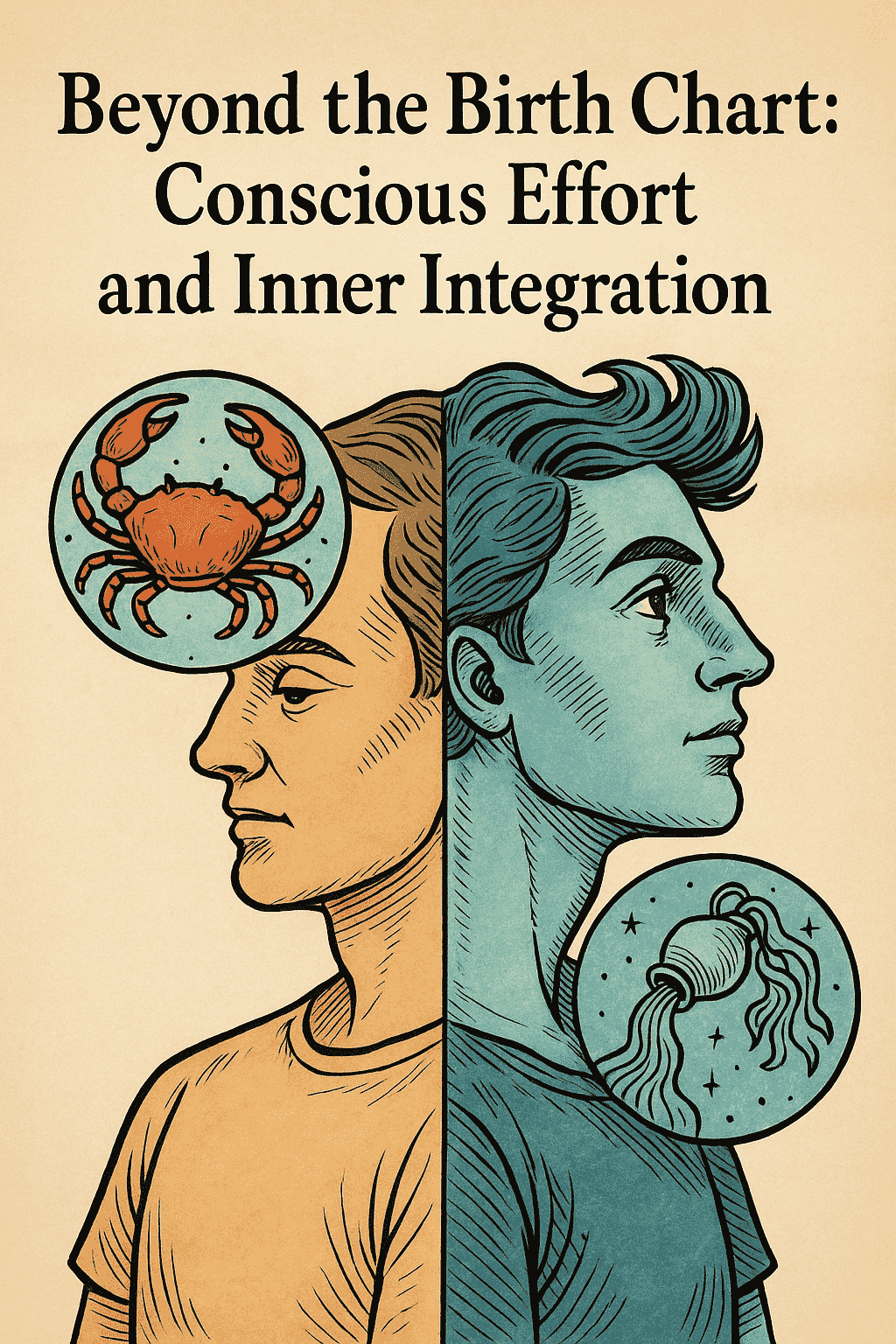Let us now turn to the fourth and decisive factor shaping one’s character: the conscious efforts an individual makes toward the development and integration of their personality.
Most natal charts display internal divisions — opposing and conflicting planetary and zodiacal influences — which operate in turn, often creating confusion within the person and in their interactions with others. These polarities manifest as inner contradictions, difficulties in expressing core traits, and psychological friction, such as through square aspects and oppositions.
We can either allow these elements to operate in chaos, or we can strive to balance and harmonize them, aligning our behavior into a more consistent, authentic, and mature expression. This inner work and its transformative results are often symbolically referred to as “transcending the birth chart.”
No chart — however difficult or challenging — is entirely fated. Every person has the capacity, if they so choose, to confront and work through the disharmonies within themselves. Of course, we do not suggest one can wholly erase or become someone else — the essential traits remain. But they can be organized, channeled, and made to work in unity, rather than at odds with each other. Through this, the person ceases to be internally fragmented and begins to experience psychological cohesion.
A Case Study: Cancer and Aquarius
Let us take, for example, an individual with strong Cancerian and Aquarian influences. This combination is inherently contradictory.
Cancer seeks warmth, emotional security, domestic peace, and a sense of belonging rooted in tradition and continuity. It is sensitive, nurturing, and cautious.
In contrast, Aquarius craves independence, collective ideals, rebellion against convention, and a vision of the future. It is free-spirited, progressive, and intellectually detached.
This person faces an intense inner struggle. When they act in alignment with Cancer, Aquarius feels trapped and suffocated. When Aquarius leads, Cancer trembles in the face of instability and uncertainty.
Such a person may long deeply for a committed relationship, home, and emotional safety — and then, once they begin to attain these, they may instinctively disrupt it all in search of autonomy and change. Ironically, even when pursuing freedom, they may not enjoy it fully — for Cancer will be pulling them back into a longing for comfort and intimacy.
The Path to Balance
The solution is not to suppress either side, but to recognize and consciously reconcile them.
When building a relationship that satisfies the Cancerian side, they must ensure Aquarius is not silenced. If that side is denied expression, inner collapse will follow. Conversely, if Aquarius dominates, Cancer will feel abandoned and unsafe.
The goal is a dynamic balance, where both energies support and refine each other. Cancer can temper Aquarius’s detachment, grounding it in emotional sincerity. Aquarius, in turn, can lend strength and vision to Cancer, lifting it beyond emotional vulnerability and fear.
The personality then becomes not a battlefield of opposing forces, but a cohesive and multidimensional whole, where contradiction gives way to creative synergy.
Conflict as Opportunity
This example is just one of many. Most charts contain contradictions — some stark, others more subtle. Yet it is precisely these inner frictions that often fuel growth or destruction.
Experience shows that a chart with many squares and oppositions, though difficult, often propels the soul forward far more than one full of trines and sextiles. The latter may offer ease and grace, but may also encourage laziness, complacency, or lack of motivation — there is no inner antagonist to overcome.
By contrast, a chart full of tension demands introspection, effort, and inner work. Through this long and sometimes painful struggle, the individual may reach levels of self-awareness and personal integration they would never have touched otherwise.
The Outcome Depends On…
How far one goes depends on several factors — including their inherent psychological maturity, their willingness to engage in self-reflection, and the external conditions that may either support or hinder their journey.
If external challenges are not overwhelming and the person has the will to fight inwardly, they may reach heights that would have remained closed to them without these very difficulties.
On the other hand, when inner strength is lacking and the individual has no interest in analysis or self-examination, they may fall victim to their own contradictions. They repeat the same mistakes, blame themselves or fate, and slowly develop neuroses as a result of unresolved internal conflicts.
Ultimately, a chart filled with challenges may prove far more enriching than one filled only with ease. Ideally, a balanced chart — combining tension (squares and oppositions) with release points (trines and sextiles) — offers both struggle and resolution. It allows for dynamic growth without crushing the spirit.
Still, no matter how ideal a chart may be, personal development never happens automatically. Conscious, persistent effort is essential — sometimes over many years. The journey is demanding and often painful, but it is also redemptive and deeply transformative.

